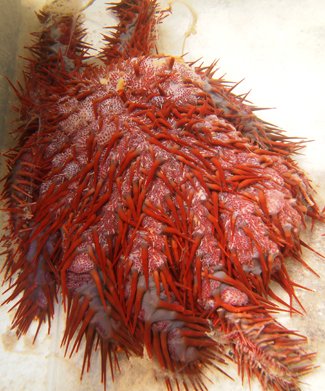New hope to stop crown of thorns destroying reefs

A NEW METHOD for controlling outbreaks of crown-of-thorns starfish is providing new hope for the future of the Great Barrier Reef.
Marine scientists have discovered that injecting a protein mixture into the coral-feeding starfish (Acanthaster planci) induces disease, killing the pest within 24 hours. If deemed ecologically safe, the method could provide a fast, cost-effective means of controlling the invader, with significant benefits for the iconic reef.
Crown-of-thorns starfish (COTS) outbreaks are one of the leading causes of coral death on the Great Barrier Reef. Since 1985, the reef has lost more than half its coral cover and COTS are responsible for 42 per cent of that loss.
Crown of thorns starfish: Reef killer
“A crown-of-thorns outbreak can destroy from 40 to 90 per cent of the corals on a reef,” says lead researcher Dr Jairo Rivera Posada, with the ARC Centre of Excellence for Coral Reef Studies at James Cook University (JCU) in Townsville. “There were massive outbreaks in many countries in the 1960s and 1980s and a new one is well underway on the Great Barrier Reef.”
The protein mixture – derived mainly from cattle – works in two ways. It promotes the rapid growth of Vibrio bacteria, which naturally live inside the starfish, but which attack their hosts when the protein gives them the right conditions to bloom. The protein also causes a dangerous allergic reaction.
Under favourable conditions – such as warms temperatures and low salinity – the bacterial infection can even spread to other starfish on contact, much like a naturally induced disease.
Protecting the Great Barrier Reef ecosystem
“We need to investigate the safety of the protein solution because we don’t want to infect other marine organisms [such as] corals and fishes, so that’s the next step,” Jairo told Australian Geographic. “We hope we can at least improve the efficiency of control efforts.”
“In developing a biological control you have to be very careful to target only the species you are aiming at, and be certain that it can cause no harm to other species or to the wider environment, says co-worker Professor Morgan Pratchett at JCU. “This compound looks very promising from that standpoint – though there is a lot of tank testing still to do before we would ever consider trialling it in the sea.”
Should the protein mixture prove ecologically safe, divers will inject adult starfish individually using a rapid jabbing method. They will target areas of the reef where new outbreaks are occurring and sections that are heavily frequented by tourists.
Jairo says it is too early to tell how quickly the bacteria will spread between individual starfish, but adds that this method of biological control will be more efficient than the current method, which involves divers much more carefully administering large quantities of sodium bisulphate over greater areas.
Jairo adds that improving water quality is also crucial to ensuring long-term reduction of starfish numbers. “One starfish can produce up to five million eggs and with all the sewage, run-off, sediment and pesticides we are putting into the reef, we are giving them all the food they need to survive,” he says.
Getting on top of the crown of thorns
John Gunn, CEO of the Australian Institute of Marine Sciences, says that “getting on top of crown-of-thorns is one of the strongest opportunities we have of giving the reef a future while we’re overcoming a range of the other challenges to do with climate change.”
John, who was not involved in the study, says the work on the protein-injection is valuable, but it’s also part of a bigger picture of research.
“Any measure that offers the potential to aid in killing starfish on the reef is very important and worth pursuing,” he says. “But I think it is really too early for us to stand up and say this is the method that will work, or that we don’t need to invest in other forms of experimental work to come up with a large-scale solution.”
The research was part of Jairo’s PhD thesis, which was published in late 2011 and announced last week by JCU.
RELATED STORIES

